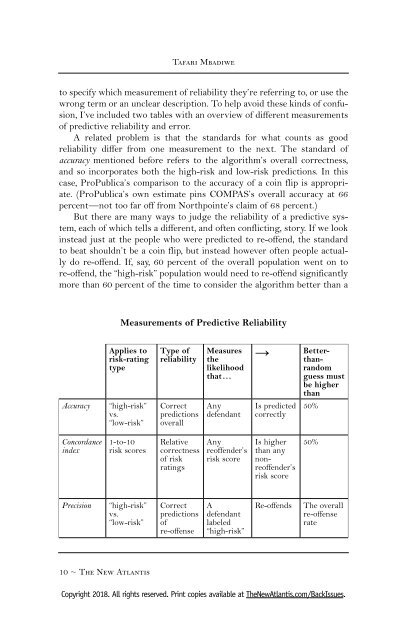The New Atlantis - Winter 2018 (Issue 54) uncompressed with cover
Create successful ePaper yourself
Turn your PDF publications into a flip-book with our unique Google optimized e-Paper software.
Tafari Mbadiwe<br />
to specify which measurement of reliability they’re referring to, or use the<br />
wrong term or an unclear description. To help avoid these kinds of confusion,<br />
I’ve included two tables <strong>with</strong> an overview of different measurements<br />
of predictive reliability and error.<br />
A related problem is that the standards for what counts as good<br />
reliability differ from one measurement to the next. <strong>The</strong> standard of<br />
accuracy mentioned before refers to the algorithm’s overall correctness,<br />
and so incorporates both the high-risk and low-risk predictions. In this<br />
case, ProPublica’s comparison to the accuracy of a coin flip is appropriate.<br />
(ProPublica’s own estimate pins COMPAS’s overall accuracy at 66<br />
percent — not too far off from Northpointe’s claim of 68 percent.)<br />
But there are many ways to judge the reliability of a predictive system,<br />
each of which tells a different, and often conflicting, story. If we look<br />
instead just at the people who were predicted to re-offend, the standard<br />
to beat shouldn’t be a coin flip, but instead however often people actually<br />
do re-offend. If, say, 60 percent of the overall population went on to<br />
re-offend, the “high-risk” population would need to re-offend significantly<br />
more than 60 percent of the time to consider the algorithm better than a<br />
Measurements of Predictive Reliability<br />
Applies to<br />
risk-rating<br />
type<br />
Type of<br />
reliability<br />
Measures<br />
the<br />
likelihood<br />
that...<br />
→<br />
Betterthanrandom<br />
guess must<br />
be higher<br />
than<br />
Accuracy<br />
“high-risk”<br />
vs.<br />
“low-risk”<br />
Correct<br />
predictions<br />
overall<br />
Any<br />
defendant<br />
Is predicted<br />
correctly<br />
50%<br />
Concordance<br />
index<br />
1-to-10<br />
risk scores<br />
Relative<br />
correctness<br />
of risk<br />
ratings<br />
Any<br />
reoffender’s<br />
risk score<br />
Is higher<br />
than any<br />
nonreoffender’s<br />
risk score<br />
50%<br />
Precision<br />
“high-risk”<br />
vs.<br />
“low-risk”<br />
Correct<br />
predictions<br />
of<br />
re- offense<br />
A<br />
defendant<br />
labeled<br />
“high-risk”<br />
Re-offends<br />
<strong>The</strong> overall<br />
re-offense<br />
rate<br />
10 ~ <strong>The</strong> <strong>New</strong> <strong>Atlantis</strong><br />
Copyright <strong>2018</strong>. All rights reserved. Print copies available at <strong>The</strong><strong>New</strong><strong>Atlantis</strong>.com/Back<strong>Issue</strong>s.


